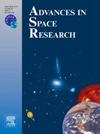Satellite-based re-examination of global soil moisture variation
IF 2.8
3区 地球科学
Q2 ASTRONOMY & ASTROPHYSICS
引用次数: 0
Abstract
It was crucial to capture the variation in global soil moisture for exploring the global eco-hydrological processes. Based on the global soil moisture data from the Climate Change Initiative (CCI) published by the European Space Agency (ESA), this study re-examined the spatial pattern and temporal trend of global soil moisture from 1978 to 2021. Our results showed that the global mean soil moisture was 0.208 cm3·cm−3, which showed a weak decreasing trend over the past four decades (−1.2 × 10-4 cm3·cm−3 yr−1, R2 = 0.23, p = 0.001). Spatially, about 12.99 % of the land showed a significant drying trend, while only 6.74 % of the land showed a wetting trend. However, in the last decade, global soil moisture exhibited a distinct upward trend (7 × 10-4 cm3·cm−3 yr−1, R2 = 0.87, p = 0.000). Specifically, during this period, 5.72 % of the land showed a marked drying tendency, while 9.09 % of the land displayed a wetting trend. Soil moisture variation in the arid climate zones showed a negative contribution to the global trend, with the total contribution of −45.72 %. In contrast, soil moisture trends in temperate and cold climate zones mainly exerted positive contributions to the global trend. From a continental perspective, Asia’s positive contribution was the most significant, accounting for 39.96 %, whereas North America showed a significant negative contribution of −37.43 %. Temporally, the negative maximum change in soil moisture occurs in June-August and the positive maximum change occurs in September-November, serving as the predominant d river for the annual trend. Results of this study helped to clarify the variation of global soil moisture, which could support the sustainable water management in the changing climate.
基于卫星的全球土壤湿度变化的再检验
捕捉全球土壤湿度变化对于探索全球生态水文过程至关重要。基于欧洲空间局(ESA)气候变化倡议(CCI)的全球土壤湿度数据,对1978 - 2021年全球土壤湿度的空间格局和时间趋势进行了重新分析。结果表明,全球平均土壤湿度为0.208 cm3·cm - 3,在过去40年里呈微弱下降趋势(- 1.2 × 10-4 cm3·cm - 3 yr - 1, R2 = 0.23, p = 0.001)。从空间上看,12.99%的土地呈现明显的干燥趋势,而只有6.74%的土地呈现湿润趋势。近10年来,全球土壤湿度呈明显上升趋势(7 × 10-4 cm3·cm−3 yr−1,R2 = 0.87, p = 0.000)。其中,5.72%的土地呈现明显的干燥趋势,9.09%的土地呈现湿润趋势。干旱气候区土壤湿度变化对全球趋势的贡献为负,总贡献率为- 45.72%。温带和寒带土壤湿度变化趋势对全球趋势的贡献主要为正。从各大洲来看,亚洲的正贡献最为显著,占39.96%,而北美的负贡献显著,为- 37.43%。从时间上看,土壤湿度负变化最大值出现在6 ~ 8月,正变化最大值出现在9 ~ 11月,是年趋势的主导河流。研究结果有助于厘清全球土壤水分的变化规律,为气候变化下的可持续水资源管理提供依据。
本文章由计算机程序翻译,如有差异,请以英文原文为准。
求助全文
约1分钟内获得全文
求助全文
来源期刊

Advances in Space Research
地学天文-地球科学综合
CiteScore
5.20
自引率
11.50%
发文量
800
审稿时长
5.8 months
期刊介绍:
The COSPAR publication Advances in Space Research (ASR) is an open journal covering all areas of space research including: space studies of the Earth''s surface, meteorology, climate, the Earth-Moon system, planets and small bodies of the solar system, upper atmospheres, ionospheres and magnetospheres of the Earth and planets including reference atmospheres, space plasmas in the solar system, astrophysics from space, materials sciences in space, fundamental physics in space, space debris, space weather, Earth observations of space phenomena, etc.
NB: Please note that manuscripts related to life sciences as related to space are no more accepted for submission to Advances in Space Research. Such manuscripts should now be submitted to the new COSPAR Journal Life Sciences in Space Research (LSSR).
All submissions are reviewed by two scientists in the field. COSPAR is an interdisciplinary scientific organization concerned with the progress of space research on an international scale. Operating under the rules of ICSU, COSPAR ignores political considerations and considers all questions solely from the scientific viewpoint.
 求助内容:
求助内容: 应助结果提醒方式:
应助结果提醒方式:


